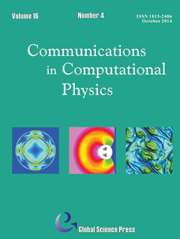Article contents
Finite Element Algorithm for Dynamic Thermoelasticity Coupling Problems and Application to Transient Response of Structure with Strong Aerothermodynamic Environment
Published online by Cambridge University Press: 31 August 2016
Abstract
As an exploratory study for structural deformation and thermodynamic response induced by spacecraft reentry aerodynamic force and thermal environment, a finite element algorithm is presented on the basis of the classic Fourier heat conductive law to simulate the dynamic thermoelasticity coupling performance of the material. The Newmark method and Crank-Nicolson scheme are utilized to discretize the dynamic thermoelasticity equation and heat conductive equation in the time domain, respectively, and the unconditionally stable implicit algorithm is constructed. Four types of finite-element computing schemes are devised and discussed to solve the thermodynamic coupling equation, all of which are implemented and compared in the computational examples including the one-dimensional transient heat conduction in considering and not considering the vibration, the transient heat flow for the infinite cylinder, and the dynamic coupling thermoelasticity around re-entry flat plate from hypersonic aerothermodynamic environment. The computational results show that the transient responses of temperature and displacement field generate lag phenomenon in case of considering the deformation effect on temperature field. Propagation, rebounding, attenuation and stabilized phenomena of elastic wave are also observed by the finite-element calculation of thermodynamic coupling problem considering vibration and damping, and the oscillation of the temperature field is simultaneously induced. As a result, the computational method and its application research platform have been founded to solve the transient thermodynamic coupling response problem of the structure in strong aerodynamic heating and force environment. By comparing various coupling calculations, it is demonstrated that the present algorithm could give a correct and reliable description of transient thermodynamic responses of structure, the rationality of the sequentially coupling method in engineering calculation is discussed, and the bending deformation mechanism produced by the thermodynamic coupling response from windward and leeward sides of flying body is revealed, which lays the foundation in developing the numerical method to solve material internal temperature distribution, structural deformation, and thermal damage induced by spacecraft dynamic thermoelasticity coupling response under uncontrolled reentry aerothermodynamic condition.
Keywords
Information
- Type
- Research Article
- Information
- Copyright
- Copyright © Global-Science Press 2016
References
- 32
- Cited by

